| Monterey Formation | |
|---|---|
| Stratigraphic range: Early to Late Miocene, 18–6 Ma PreꞒ Ꞓ O S D C P T J K Pg N | |
 Outcrop of Monterey Formation, Gaviota State Park, California Outcrop of Monterey Formation, Gaviota State Park, California | |
| Type | sedimentary |
| Unit of | Los Angeles Basin |
| Underlies | Sisquoc Formation, Capistrano Formation |
| Overlies | Rincon Formation |
| Lithology | |
| Primary | Shale, sandstone |
| Other | Diatomite, oil shale |
| Location | |
| Coordinates | 33°36′N 117°42′W / 33.6°N 117.7°W / 33.6; -117.7 |
| Approximate paleocoordinates | 33°06′N 114°54′W / 33.1°N 114.9°W / 33.1; -114.9 |
| Region | |
| Country | |
| Type section | |
| Named for | Monterey, California |
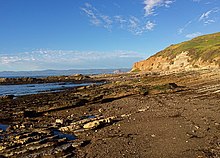

| External image | |
|---|---|
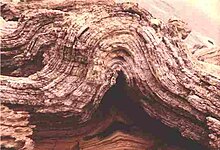



The Monterey Formation is an extensive Miocene oil-rich geological sedimentary formation in California, with outcrops of the formation in parts of the California Coast Ranges, Peninsular Ranges, and on some of California's off-shore islands. The type locality is near the city of Monterey, California. The Monterey Formation is the major source-rock for 37 to 38 billion barrels of oil in conventional traps such as sandstones. This is most of California's known oil resources. The Monterey has been extensively investigated and mapped for petroleum potential, and is of major importance for understanding the complex geological history of California. Its rocks are mostly highly siliceous strata that vary greatly in composition, stratigraphy, and tectono-stratigraphic history.
The US Energy Information Administration (EIA) estimated in 2014 that the 1,750 square mile Monterey Formation could, as an unconventional resource, yield about 600 million barrels of oil, from tight oil contained in the formation, down sharply from their 2011 estimate of a potential 15.4 billion barrels. An independent review by the California Council on Science and Technology found both of these estimates to be "highly uncertain." Despite intense industry efforts, there has been little success to date (2013) in producing Monterey-hosted tight oil/shale oil, except in places where it is already naturally fractured, and it may be many years, if ever, before the Monterey becomes a significant producer of shale oil.
The Monterey Formation strata vary. Its lower Miocene members show indications of weak coastal upwelling, with fossil assemblages and calcareous-siliceous rocks formed from diatoms and coccolithophorids. Its middle and upper Miocene upwelling-rich assemblages, and its unique highly siliceous rocks from diatom-rich plankton, became diatomites, porcelainites, and banded cherts. It generally dates to between 16 to 7 million years ago, but some sections are as early as 18 million years old or as young as 6 million years old. Most of the formation's sediments appear to represent siliceous shales deposited at the edge of the continental shelf or in abyssal plains in the lower to middle bathyal zone. These deep-sea sediments were brought to the surface via tectonic activity. A similar depositional environment and geologic history is known for the adjacent, contemporaneous Modelo Formation, which preserves a similar paleobiota.
Shale oil resources and exploitation
The Monterey formation has long been recognized as the primary source of the oil produced from other formations in Southern California; the Monterey itself has been very productive where it is naturally fractured. Since 2011, the possibility that hydraulic fracturing might make the Monterey Shale productive over large areas has gained widespread public attention.
According to the US Energy Information Administration (EIA) in 2011, the 1,750-square-mile (4,500 km) Monterey Shale Formation contained more than half of the United States's total estimated technically recoverable shale oil (tight oil contained in shale, as distinct from oil shale) resource, about 15.4 billion barrels (2.45×10^ m). In 2012, the EIA revised its recoverable volume downward, to 13.7 billion barrels (2.18×10^ m). As of 2013 advances in hydraulic fracturing commonly called "fracking," and the high price of oil resulted in spirited bidding by oil companies for leases. Occidental Petroleum and Venoco were reported to have been major players. The deposit lies 6,000 and 15,000 feet (1,800 and 4,600 m) below the surface.
A widely cited March 2013 study released by the University of Southern California (USC) estimated that if extensive resource play development of the Monterey through hydraulic fracturing were successful, it could generate as many as 2.8 million jobs and as much as $24.6 billion in state and local taxes. However, observers have pointed out that as of 2012, however large its theoretical potential, no one as yet has succeeded in making the Monterey Shale widely economic through hydraulic fracturing; to date it has been economic only in those limited locations already naturally fractured.
Richard Behl, a geology professor who heads the "Monterey And Related Sediments" (MARS) consortium at California State University Long Beach, said that "The numbers probably were overblown, but it was a simple method and had an essence of truth." Compared to other shale oil plays, the Monterey formation is much thicker and more laterally extensive, but also much more geologically complex and deformed. See the linked photos from a field trip to Monterey outcrops at Vandenberg Air Force Base. "To say California geology is complex is an understatement. ... The Monterey play is no slam-dunk." In 2013, Bakken shale-oil pioneer Harold Hamm said the Monterey "might have a lot of potential, but there are reasons why it’s not being produced."
J. David Hughes, a Canadian geoscientist and Fellow of Post Carbon Institute, published a report in December 2013 analyzing the assumptions behind the EIA's forecast of Monterey tight oil production and the USC's forecast of resulting job and tax revenue growth. He found the EIA report's assumptions on prospective well productivity to be "extremely optimistic," and the total estimate of 15.4 billion barrels of recoverable oil "highly overstated." He also found the USC study's assumption that development of the Monterey shale could increase California oil production as much as seven-fold to be "unfounded," and the economic projections regarding jobs and tax revenue to be "extremely suspect."
Source rock
The Monterey Formation is considered the source of 84% of the oil in known fields of the San Joaquin Basin, a total of 12.2 billion barrels of oil. Of this, 112 million barrels of oil in known fields is produced from the Monterey itself.
The Monterey formation is the source for such giant oilfields as the Kern River, Elk Hills, Midway-Sunset Oil Field, and probable source for the overlying North and South Belridge Oil Fields.
History
Monterey Formation oil was discovered at the Orcutt Oil Field in the Santa Maria Basin of Santa Barbara County in 1901. This was quickly followed by other Monterey discoveries nearby, including the Cat Canyon Oil Field and Lompoc Oil Field. Each of these early Monterey discoveries depended on natural fractures in the Monterey.
The Monterey Formation is one of the reservoirs in the Elk Hills Oil Field as well as one of the reservoirs (Belridge Diatomite) of the Lost Hills Oil Field, both located in Kern County.
Major Monterey production was also discovered in offshore oil fields, such as the South Ellwood Oil Field in the Santa Barbara Channel, and the Point Arguello Field in the Santa Maria Basin.
The North Shafter and Rose oil fields of Kern County, which produce primarily from the Monterey Formation, were discovered in 1983, but attempts to produce the oil have not been highly economic. Some horizontal wells were drilled in the Rose field in the early 2000s, with 2,500-foot lateral lengths and single-stage open-hole fracs; the results were said to be improvements over vertical wells.
Carbon dioxide injection has been tested in the Monterey shale, with mixed results. "The main problem was that the carbon dioxide didn't increase production as much as hoped. ... That could be because the rock formation is so jumbled up, it's hard to find the right spot in which to inject the carbon dioxide."
Oil companies such as Occidental Petroleum are using acidizing to stimulate production in Monterey wells, and other companies are experimenting with proprietary mixes of hydrochloric and hydrofluoric acids. "There's a lot of discussion around the Monterey Shale that it doesn't require fracking, that acidizing will be enough to open up the rock," said Chris Faulkner, chief executive officer of Breitling Oil and Gas.
Opposition and regulation
The Monterey Formation underlies the southern half of the San Joaquin Valley, a prime agricultural region. The possibility of environmental damage has caused some farmers in Kern County to press for close regulation of hydraulic fracturing.
Opponents say that hydraulic fracturing poses risks in the seismically active region.
The California legislature passed a bill regulating fracking in September 2013. Some environmentalists criticised the bill as being too lax. Some environmentalists promised not to rest until fracking is banned completely. Oil industry representatives criticized the bill as too restrictive. The measure was supported by state Sen. Fran Pavley, author of a fracking bill defeated the previous year. The bill, which Governor Jerry Brown promised to sign, provided for disclosure of chemical used, pre-testing of nearby water wells, and a study on environmental and safety issues to be completed by January 2015. Given the very limited success with fracking the Monterey to date, some find the controversy "much ado about little."
In Santa Barbara County, Santa Maria Energy LLC (SME) has proposed a total of 136 wells in the Monterey formation that would use cyclic steam injection to produce tight oil. In 2013, the county planning commission declined its staff's recommendation to approve the project, calling for more study on concerns raised by environmentalists about greenhouse-gas emissions. The County Board of Supervisors approved the proposed project on November 18, 2013 and SME was cited as a model operator and applicant during the proceedings.
Vertebrate paleofauna
The Monterey Formation preserves a very diverse, primarily marine assemblage of fossil taxa. The most diverse assemblage with the most well-preserved, articulated specimens originates from the presumably Tortonian-aged diatomite deposits exposed in the former Celite Company/Johns Mansfield quarry in Lompoc. However, the age and even formation of these deposits is disputed, as some sources attribute them to the overlying Sisquoc Formation instead.
Cartilaginous fish
Based on the Paleobiology Database:
| Genus | Species | Location | Member | Material | Notes | Images |
|---|---|---|---|---|---|---|
| Carcharhinus | C. sp. | Leisure World | A requiem shark. | 
| ||
| Carcharodon | C. arnoldi | Lompoc | A relative of the great white shark. | |||
| C. hastalis | 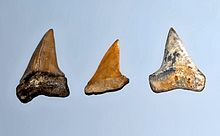
| |||||
| C. planus | Leisure World | |||||
| Cetorhinus | C. sp. | Leisure World | A relative of the basking shark. | 
| ||
| Galeocerdo | G. aduncus | Aliso Viejo | A relative of the tiger shark. | 
| ||
| Hexanchus | H. sp. | A sixgill shark. | 
| |||
| Isurus | I. sp. | A mako shark. | 
| |||
| Myliobatis sp. | Laguna Niguel, Leisure World | An eagle ray. | 
| |||
| Otodus | O. megalodon | Altamira Shale, Laguna Niguel, Leisure World, El Toro | Altamira Shale, Lower | A megatooth shark, the megalodon. | 
| |
| Sphyrna | S. sp. | Laguna Niguel | A hammerhead shark. | 
| ||
| Strongyliscus | S. robustus | Lompoc | Isolated dorsal spine | A bullhead shark. |
Bony fish
Based on Fierstine et al (2012) and the Paleobiology Database.
| Genus | Species | Location | Member | Material | Notes | Images |
|---|---|---|---|---|---|---|
| Acipenseridae indet. | Mission Viejo | Disarticulated partial skeleton. | A sturgeon of uncertain affinities. | |||
| Achrestogrammus | A. achrestus | Lompoc | Articulated partial skeleton | A presumed greenling. | ||
| Araeosteus | A. rothi | Lompoc | Articulated skeletons | A relative of the prowfish. | ||
| Argyropelecus | A. affinis | Valmonte Diatomite | Articulated skeletons, whereabouts uncertain | The modern Pacific hatchetfish. | 
| |
| A. bullockii | Lompoc | Articulated skeletons | A marine hatchetfish. | |||
| Bathylagus | B. angelensis | Bairdstown, El Modena, Lompoc | Articulated skeletons | A deep-sea smelt. | 
| |
| Bolbocara | B. gyrinus | Lompoc | Articulated skeleton | A grenadier. | 
| |
| Chauliodus | C. eximius | Lompoc | Articulated skeletons | A viperfish. | 
| |
| Cyclothone (=Rogenio) | C. cf. solitudinis | Bairdstown | Articulated skeleton | A bristlemouth. | 
| |
| C. sp. | El Modena | |||||
| Cynoscion | C. eprepes | Lompoc | Partial articulated skeletons | A weakfish. | 
| |
| Decapterus | D. hopkinsi | Articulated skeletons | A mackerel scad. | 
| ||
| Drimys | D. defensor | Lompoc | Articulated skeleton | A barracudina. | 
| |
| Eclipes | E. cf. extensus | Altamira Shale | Articulated skeletons | A cod. | ||
| E. manni | Lompoc | |||||
| E. veternus | El Modena | |||||
| Emmachaere | E. rhomalea (=E. rhachites) | Lompoc | Articulated skeletons. | A goosefish. | ||
| Eoscorpius | E. primaevus | Bairdstown | Lost partial skeleton | A presumed sablefish, but potentially a scombrid. | ||
| Etringus | E. sp. | Altamira Shale | Scales | A herring. | ||
| Eriquius | E. plectrodes | Lompoc | Articulated skeleton. | A surfperch. | ||
| Eritima | E. evides | Bairdstown | Articulated skeleton. | A cardinalfish. | ||
| Euleptorhamphus | E. peronides | Lompoc | Articulated skeletons. | A halfbeak. Attribution to Euleptorhamphus doubted. | 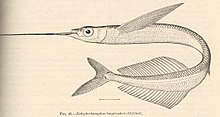
| |
| Euzaphleges | E. longurio | Lompoc | Articulated skeletons. | A euzaphlegid scombroid. | 
| |
| Evesthes | E. jordani | Lompoc | Articulated skeletons. | A large-tooth flounder. | ||
| Forfex | F. hypuralis | Pine Canyon | Articulated skeleton | A forficid beloniform. | ||
| Ganoessus | G. clepsydra | El Modena | Articulated skeleton. | A herring. | ||
| G. michaelis | Buttle | Articulated skeleton. | ||||
| Ganolytes | G. aratus | Lompoc | Articulated skeleton. | A herring. | ||
| Gasterosteus | G. aculeatus | Lompoc | Articulated skeletons. | The modern three-spined stickleback. | 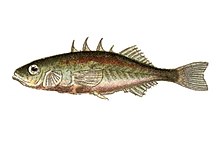
| |
| Hexagrammidae indet. | Lompoc | Lost headless skeleton | A greenling. | |||
| Hippoglossoides | H. pristinus | Lompoc | Articulated skeleton | A righteye flounder. | 
| |
| Hipposyngnathus | H. imporcitor | Lompoc | Articulated skeletons | A pipefish. | 
| |
| Ioscion | I. morgani | Lompoc | Lost partial articulated skeleton | An ioscionid percomorph, potential carangid affinities. | ||
| Istiophoridae indet. | Predentary | A marlin of uncertain affinities. | ||||
| Lampanyctus (=Engraulites) | L. remifer | Lompoc | Articulated skeletons. | A lanternfish, formerly considered an anchovy. | 
| |
| Lampanyctinae indet. | Lompoc | Articulated skeleton | A lanternfish. | |||
| Lampris | L. zatima | Lompoc, El Capitan Beach | Articulated partial skeletons | A relative of the opah. | 
| |
| Lirosceles | L. elegans | Lompoc | Articulated skeleton | A cottid sculpin. | ||
| Lompoquia | L. culveri | Lompoc | Articulated skeleton | A drumfish. | 
| |
| L. retropes | ||||||
| Makaira | M. nigricans (sensu lato) | Rostral fragment | The modern blue marlin. | 
| ||
| Megalops | ?M. vigilax (=Starrias ischyrus) | Lompoc | Articulated partial skeleton | A tarpon. | 
| |
| Molidae indet. | An ocean sunfish. | |||||
| Ocystias | O. sagitta | Lompoc | Lost articulated skeleton | A scombrid. | ||
| Ophiodon | O. ozymandias | Lompoc | Partial articulated segment | A relative of the lingcod. | 
| |
| Opisthonema | O. palosverdensis | Altamira Shale | Articulated skeleton | A thread herring. | 
| |
| Ozymandias | O. gilberti | Lompoc | Vertebral segment, skull | A scombrid. | ||
| Paralichthys | P. antiquus | Lompoc | Head, body fragment | A large-tooth flounder. | 
| |
| Plectrites | P. classeni | Lompoc | Articulated skeletons | A seabream. | ||
| Pleuronichthys | P. veliger | Lompoc | Articulated skeleton | A righteye flounder. | 
| |
| Protanthias | P. fossilis | Lompoc | Articulated skeleton | An anthias. | ||
| Pseudoseriola | P. sanctaeineziae | Lompoc | Articulated skeleton | A relative of the bluefish. | ||
| Quaesita | Q. quisquilia | El Modena | Articulated skeletons | A deep-sea smelt. | ||
| Quisque | Q. gilberti | El Modena | Slab with numerous articulated skeletons. | A herring. | ||
| Rythmias | R. starri | Lompoc | Articulated skeletons | A seabream. | ||
| Sarda | S. stockii | Lompoc | Lost partial skeleton | A bonito. | 
| |
| Scomber | S. cf. japonicus (=Turio wilburi, T. culveri, Thyrsion velox, Pneumatophorus cf. grex) | Lompoc | Articulated skeletons | A true mackerel, tentatively referred to the modern chub mackerel. | 
| |
| S. sanctaemonicae (=Auxides sanctaemonicae) | Brown's Canyon | Partial articulated skeleton | A true mackerel. | |||
| Scomberessus | S. acutillus | El Modena | Articulated skeletons. | A saury, possibly conspecific with Scomberesox edwardsi. | ||
| Scorpaena | S. ensiger | El Modena | Articulated skeletons | A scorpionfish. | 
| |
| Scorpaenidae indet. (=Lutjanus hagari) | El Modena | Articulated skeleton | A scorpionfish, potentially in Stereolepis. | |||
| Sebastes | S. apostates | Lompoc | Articulated skeletons | A rockfish. | 
| |
| S. davidi | ||||||
| S. defunctus | ||||||
| S. ineziae | ||||||
| S. longirostris | ||||||
| S. porteousi | ||||||
| S. thermophilus | ||||||
| S. velox | ||||||
| Sebastinus | S. sp. | Lompoc | Lost specimen | A rockfish. | ||
| Seriola | S. sanctaebarbarae | Lompoc | Articulated skeletons | An amberjack. | 
| |
| Syngnathus | S. avus | Bairdstown, El Modena | Articulated skeletons | A pipefish. | 
| |
| Thyrsocles | T. kriegeri | Lompoc | Articulated skeletons | A euzaphlegid. | 
| |
| Thunnus | T. starksi | Lompoc | Articulated skeleton, head fragment | A tuna. | 
| |
| T. sp. | Altamira Shale | Articulated skeleton, fragments | ||||
| Trossulus | ?T. exoletus | Lompoc | Lost articulated skeletons | A presumed euzaphlegid. | ||
| Tunita | T. octavia | El Modena | Partial articulated skeleton | A scombrid. | ||
| Xestias | X. iratus | Lompoc | Skull, articulated skeleton | A scombrid. | ||
| Xyne | X. grex | Lompoc | Multiple slabs with numerous articulated skeletons | A herring, known from huge fossilized mass mortality assemblages of spawning individuals. | ||
| Xyrinius | X. barbarae | Carpenteria | Lost skeletons | A herring that may be potentially conspecific with Xyne grex. It is uncertain whether X. houshi is from the Monterey Formation. | ||
| X. elmodenae | El Modena | |||||
| ?X. houshi | ||||||
| Zanteclites | Z. hubbsi | Bairdstown | Articulated skeleton | A Neotropical silverside. | ||
| Zelosis | Z. hadleyi | El Modena | Articulated skeleton | A halfbeak. |
Birds
Based on the Paleobiology Database:
| Genus | Species | Location | Member | Material | Notes | Images |
|---|---|---|---|---|---|---|
| Aethia | A. rossmoori | Lower | An auklet. | 
| ||
| Alcodes | A. ulnulus | Lower | A Lucas auk. | |||
| Cerorhinca | C. dubia | Lompoc | A relative of the rhinoceros auklet. | 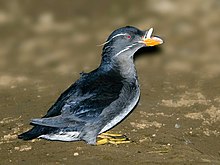
| ||
| C. sp. | Lower | |||||
| Diomedea | D. sp. | A great albatross. | 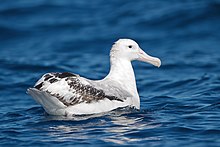
| |||
| Fulmarus | F. hammeri | Lower | A fulmar. | 
| ||
| Gavia | G. brodkorbi | A loon. | 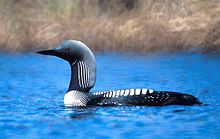
| |||
| Limosa | L. vanrossemi | Lompoc | A godwit. | 
| ||
| Morus | M. lompocanus | Lompoc, Monterey | A gannet. | 
| ||
| M. magnus | ||||||
| M. media (=Miosula) | Lompoc | |||||
| M. willetti (=Sula willetti) | Lompoc | |||||
| Microsula | M. sp. | Lower | A sulid. | |||
| Miomancalla | M. wetmorei | A Lucas auk. | 
| |||
| Oceanodroma | O. sp. | A storm petrel. | ||||
| Osteodontornis | O. orri | Tepusquet Creek | A pseudotooth bird. | 
| ||
| Palaeoscinis | P. turdirostris | Tepusquet Creek | Articulated skeleton | A songbird. | ||
| Phoebastria | P. anglica | A North Pacific albatross. | 
| |||
| Procellaridae indet. | Tepusquet Creek | A tubenose of uncertain affinities. | ||||
| Praemancalla | P. lagunensis | Lower | A Lucas auk. | |||
| Presbychen | P. abavus | Lower | A goose. | |||
| Puffinus | P. barnesi | A shearwater. | ||||
| P. calhouni | Lower | 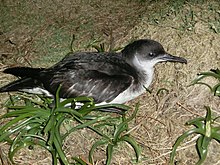
| ||||
| P. diatomicus | Lompoc | |||||
| P. priscus | Lower | |||||
| Uria | U. brodkorbi | Lompoc | Articulated skeleton. | A murre. | 
|
Reptiles
Based on the Paleobiology Database:
| Genus | Species | Location | Member | Material | Notes | Images |
|---|---|---|---|---|---|---|
| Crocodylia indet. | A crocodilian of uncertain affinities. | |||||
| aff. Dermochelys | D. sp. | Lower | A potential relative of the leatherback turtle. | 
| ||
| Psephophorus | P. sp. | Lower | A dermochelyid sea turtle. | 
|
Mammals
Cetaceans
| Genus | Species | Location | Member | Material | Notes | Images |
|---|---|---|---|---|---|---|
| Albicetus | A. oxymycterus | Santa Barbara | A physeteroid toothed whale. | 
| ||
| Albireonidae indet. | Laguna Niguel | An albireonid toothed whale. | ||||
| Atocetus | A. nasalis | Laguna Niguel | A kentriodontid toothed whale. | 
| ||
| "Balaenoptera" | "B." ryani | Monterey Bay | A baleen whale of uncertain affinities. | |||
| Delphinapterinae indet. | Laguna Niguel | A relative of the beluga whale. | ||||
| Delphinavus | D. newhalli | Suey Ranch | A delphinidan of uncertain affinities. | |||
| aff. Kampholophos | K. sp. | El Toro | A kentriodontid toothed whale. | |||
| Kogiidae indet. | Laguna Niguel | A relative of the dwarf sperm whales. | ||||
| Liolithax | L. kernensis | El Toro, Leisure World | A kentriodontid toothed whale. | |||
| aff. Messapicetus | M. sp. | Laguna Niguel | A beaked whale. | 
| ||
| Mixocetus | M. sp. | Laguna Niguel | A tranatocetid baleen whale. | 
| ||
| Nannocetus | N. sp. | Laguna Niguel | A cetothere. | |||
| Norrisanima | N. miocaena | Lompoc | A stem-rorqual whale. | |||
| Piscolithax | P. tedfordi | Laguna Niguel | A porpoise. | |||
| Pithanodelphis | P. sp. | Laguna Niguel, El Toro | A kentriodontid toothed whale. | |||
| Salumiphocaena | S. stocktoni | Palos Verdes, El Toro | Valmonte | A porpoise. | ||
| Scaldicetus | S. sp. | El Toro | A physeterid toothed whale. | 
| ||
| Zarhinocetus | Z. errabundus | Aliso Viejo | Lower | An allodelphinid toothed whale. |
Perissodactylans
| Genus | Species | Location | Member | Material | Notes | Images |
|---|---|---|---|---|---|---|
| Pliohippus | P. sp. | El Toro | An equine. | 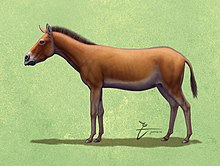
|
Desmostylians
| Genus | Species | Location | Member | Material | Notes | Images |
|---|---|---|---|---|---|---|
| Desmostylus | D. hesperus | Monterey Bay, San Luis Obispo, Solvang, Palos Verdes, Leisure World | A desmostylian. | 
| ||
| Jamilcotatus | J. boreios | Santa Cruz Island | A desmostylian, not officially named. | |||
| Neoparadoxia | N. cecilialina | Mission Viejo | A paleoparadoxiid desmostylian. | 
| ||
| Paleoparadoxia | P. sp. | Palos Verdes, Leisure World | Altamira Shale | A paleoparadoxiid desmostylian. | 
|
Carnivorans
| Genus | Species | Location | Member | Material | Notes | Images |
|---|---|---|---|---|---|---|
| Allodesmus | A. cf. sinanoensis | Leisure World | Lower | A desmatophocid pinniped. | ||
| Atopotarus | A. courseni | Palos Verdes | Altamira | A desmatophocid pinniped. | 
| |
| Borophagus | B. sp. | El Toro | A borophagine canid. | 
| ||
| Imagotaria | I. downsi | Lompoc, Laguna Niguel, Leisure World | An odobenid pinniped. | 
| ||
| Monachinae indet. | Laguna Niguel | A monachine seal. | ||||
| Pithanotaria | P. starri | Lompoc, Mission Viejo, Laguna Niguel | An eared seal. | 
| ||
| Pontolis | P. barroni | Aliso Viejo | An odobenid pinniped. | 
| ||
| P. cf. magnus | Palos Verdes | Valmonte | 
|
Sirenians
| Genus | Species | Location | Member | Material | Notes | Images |
|---|---|---|---|---|---|---|
| Dioplotherium | D. allisoni | El Toro | Lower | A dugongid related to the dugong. | 
| |
| Dusisiren | D. dewana | Upper | A dugongid related to Steller's sea cow. | 
| ||
| D. jordani | Lompoc, Moulton Ranch, Laguna Niguel, Leisure World | |||||
| Metaxytherium | M. sp. | Leisure World | A dugongid. | 
|
Paleoflora
The Monterey Formation contains some of the few examples of fossilized non-calcareous algae in the world, which tend to be preserved in diatomite.
Brown algae
| Genus | Species | Location | Member | Material | Notes | Images |
|---|---|---|---|---|---|---|
| Paleocystophora | P. subopposita | A brown algae, family Cystoseiraceae. | ||||
| Paleohalidrys | P. californica | A brown algae, family Cystoseiraceae. | ||||
| P. occidentalis | ||||||
| P. superba | ||||||
| Julescraneia | J. grandicornis | A kelp, family Lessoniaceae. |
Plants (green and red algae)
| Genus | Species | Location | Member | Material | Notes | Images |
|---|---|---|---|---|---|---|
| Caulerpites | C. denticulata | A green alga. | ||||
| Chondrides | C. flexilis | A red alga. | ||||
| Paleosiphonia | P. oppositiclada | A red alga. |
See also
References
- M.N. Bramlette (1946). The Monterey Formation of California and the Origin of its Siliceous Rocks. USGS Professional Paper 212.
- Monterey Shale Gets New Look, AAPG Explorer, Nov 2010. Accessed 03/21/2014
- The Monterey Formation of California: New Research Directions by Richard J. Behl, California State University, Long Beach, 2012
- Sahagun, Louis (May 21, 2014) "U.S. officials cut estimate of recoverable Monterey Shale oil by 96%" Los Angeles Times
- ^ Drilling California: A Reality Check on the Monterey Shale J. David Hughes, Post Carbon Institute, 2013.
- CCST Releases Report on Well Stimulation Technologies, August 28, 2014. "The 2011 EIA report suggested 15-billion barrels of recoverable oil in these source rocks but a subsequent 2014 correction by EIA reduced the estimate to 0.6 billion barrels. Recovering these resources would certainly require well stimulation. However, Berkeley Lab investigators found no reports of successful production from these deep source rocks and had questions about the EIA estimation methodology. The study's review of the two resource projections from deep source rocks in the Monterey Formation developed by EIA concluded that both these estimates are highly uncertain."
- So Much Shale Oil—but So Hard to Get, Wall Street Journal, Updated Sept. 23, 2013
- Burnett, William C.; Stanley R. Riggs, eds. (1990-05-25). Phosphate Deposits of the World: Volume 3, Neogene to Modern Phosphorites (Cambridge Earth Science Series). Cambridge University Press. ISBN 0-521-33370-9.
- Knott, Jeffrey R.; Sarna-Wojcicki, Andrei M.; Barron, John A.; Wan, Elmira; Heizler, Lynn; Martinez, Priscilla (2022-09-26), Aiello, Ivano W.; Barron, John A.; Ravelo, A. Christina (eds.), "Tephrochronology of the Miocene Monterey and Modelo Formations, California", Understanding the Monterey Formation and Similar Biosiliceous Units across Space and Time, Geological Society of America, pp. 187–214, doi:10.1130/2022.2556(08), ISBN 978-0-8137-2556-7, retrieved 2024-11-18
- Josie Garthwaite, Monterey Shale shakes up California energy future, National Geographic, 27 May 2013.
- US Energy Information administration, Review of emerging resources US shale gas and shale oil plays, July 2011.
- US Energy Information Administration, Geology and technology drive estimates of technically recoverable resources, 20 July 2012.
- The Monterey Shale and California’s Economic Future University of Southern California, USC Price School of Public Policy, (March 2013.
- David Brown, The Monterey Shale, big deal, or big bust?, AAPG Explorer, Nov, 2012.
- ^ Monterey Shale Continues to Tempt and Tease, AAPG Explorer, February 2013
- ^ Monterey/Santos: Operators struggle with cracking code, World Oil, Nov. 2013 (Google title to bypass paywall)
- Purd'homme, Alex (December 29, 2013) "'Fracking' the Monterey Shale -- boon or boondoggle?" Los Angeles Times
- Magoon and others, , US Geological Survey, Professional Paper 1713, Chapter 8.
- S.A. Reid and J.L. McIntyre, Monterey Formation porcelanite reservoirs of the Elk Hills Field, Kern County, California, American Association of Petroleum Geologists Bulletin, 2001, v.85 n.1 p.169-189.
- Pressure buildup analysis in a naturally fractured reservoir, 1983.
- Mero, W.E., Thurston, S.P., and Kropschot, R.E., 1992, The Point Arguello Field, In Giant Oil and Gas Fields of the Decade, 1978–1988, AAPG Memoir 54, Halbouty, M.T., editor, Tulsa: American Association of Petroleum Geologists, ISBN 0891813330
- Robert Sterling and others, North Shafter and Rose fields, Houston Geological Society Bulletin, 2003.
- W.A. Minner and others, Rose field, Society of Petroleum Engineers, 2003.
- ^ Oil Firms Seek to Unlock Big California Field, Wall Street Journal, Sept. 22, 2013
- Acidizing could rival fracking in Monterey Shale, San Francisco Chronicle, August 25, 2013
- Norimitsu Onishi (June 1, 2013). "Fracking Tests Ties Between California 'Oil and Ag' Interests". The New York Times. Retrieved June 2, 2013.
- Norimitsu Onishi (February 3, 2013). "Vast Oil Reserve May Now Be Within Reach, and Battle Heats Up". The New York Times. Retrieved February 4, 2013.
- Mark Melincoe, Brown says he'll sign California bill regulating fracking, Bloomberg, 12 Sept, 2013.
- Stephen Stock, California fracking law has huge holes, critics argue, NBC Bay Area, 13 Sept. 2013
- California lawmakers approve fracking bill, NBC Bay Area, 12 Sept. 2013.
- "PBDB Collection". paleobiodb.org. Retrieved 2024-12-16.
- ^ Czaplewski, John J. "PBDB Navigator". paleobiodb.org. Retrieved 2024-09-24.
- California Academy of Sciences (1890). Occasional papers of the California Academy of Sciences. California Academy of Sciences. San Francisco : California Academy of Sciences.
- "PBDB Collection". paleobiodb.org. Retrieved 2024-09-24.
- "PBDB Taxon". paleobiodb.org. Retrieved 2024-09-24.
- ^ Ksepka, Daniel T.; Tennyson, Alan J. D. (2024-01-01). "Oldest fossil record of Sulidae from New Zealand". Journal of Ornithology. 165 (1): 277–280. doi:10.1007/s10336-023-02117-0. ISSN 2193-7206.
- "Monterey Formation - Algae". ucmp.berkeley.edu. Retrieved 2024-11-18.
External links
- UCMP.Berkeley.edu: The Monterey Formation of California — from the University of California Museum of Paleontology.
- Miocene California
- Miocene geology
- Geologic formations of California
- Petroleum in California
- Oil-bearing shales in the United States
- Geology of Monterey County, California
- Geology of San Luis Obispo County, California
- Geology of Santa Barbara County, California
- Natural history of the California Coast Ranges
- Natural history of the Peninsular Ranges
- Natural history of the Transverse Ranges